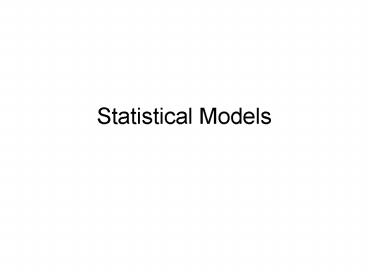Statistical Models PowerPoint PPT Presentation
1 / 21
Title: Statistical Models
1
Statistical Models
2
Typical Statistical Regression Models
3
One Problem Area
- Many people have forgotten what the intercept is
and what the slope is. - Assignment look up and be able to explain what
the intercept is and what the slope is. - Give me an example in your field give y x1 x2
hypothetical betas and interpret everything
4
Examples
Suppose, for example, that the director of a
county highway department wants to predict the
cost of a resurfacing contract that is up for
bids. We could reasonably predict the costs to be
a function of the road miles to be resurfaced. A
reasonable first attempt is to use a linear
production function. Let y total cost of a
project in thousands of dollars, x number of
miles to be resurfaced
Write down the statistical model. What are the
parameters? What are the hypotheses? How many
populations are sampled?
5
Examples
- A mail-order retailer spends considerable
effort in picking ordersselecting the
ordered items and assembling them for shipment. A
small study took a sample of 100 orders. An
experienced picker carried out the entire
process. The time in minutes needed was recorded
for each order.
Write down the statistical model. What are the
parameters? What are the hypotheses? How many
populations are sampled?
6
Examples
- A laundry detergent manufacturer wished to
test a new product prior to market release. One
area of concern was the relationship between the
height of the detergent suds in a washing machine
as a function of the amount of detergent added
and the degree of agitation in the wash cycle.
For a standard size washing machine tub filled to
the full level, random assignments of different
agitation levels (measured in minutes) and
amounts of detergent were made and tested on the
washing machine.
Write down the statistical model. What are the
parameters? What are the hypotheses? How many
populations are sampled?
7
Typical ANOVA ModelsPopulation Means Model
8
Typical ANOVA ModelsPopulation Means Model
9
Examples
- Researchers conducted an experiment to
compare the starch content of tomato plants grown
in sandy soil supplemented by one of three
different nutrients, A, B, or C. The researchers
selected 18 tomato seedlings of one particular
variety for the study, with six assigned to each
of the nutrient groups. They planted all
seedlings in a sand culture and maintained them
in a controlled environment. Those seedlings
assigned to nutrient A served as the control
group (receiving distilled water only). Plants
assigned to nutrient B were fed a weak
concentration of Hoagland nutrient, while those
assigned to nutrient C received the Hoagland
nutrient at full strength. The researchers
determined the stem starch contents 25 days after
planting the contents are recorded here, in
micrograms per milligram.
10
Questions
- Write down the statistical model both ways.
- What are the parameters?
- What are the hypotheses?
- How many populations are sampled?
11
For SAS SPSS
- Do an example
12
Example 2 by 3 Factorial
B 1
B 2
B 3
A 1
A 2
Assumptions?
13
ANOVA 2 - Factors
14
Example
- An experiment was conducted to determine the
effects of four different pesticides on the yield
of fruit from three different varieties (B1, B2,
B3) of a citrus tree. Eight trees from each
variety were randomly selected from an orchard.
The four pesticides were then randomly assigned
to two trees of each variety and applications
were made according to recommended levels. Yields
of fruit (in bushels per tree) were obtained
after the test period.
Write down the statistical model. What are the
parameters? What are the hypotheses? How many
populations are sampled?
15
The Other Model
16
Meaning
- The meaning of the parameters depends upon the
computer package. SAS and SPSS have the same
meaning - Other programs may have different meaning
17
What is being tested
18
Questions
- Write down the statistical model.
- What are the parameters?
- What are the hypotheses?
- How many populations are sampled?
19
What is being estimated / tested?
20
Parameters - 2 by 3
21
Example
- An experiment was conducted to determine the
effects of four different pesticides on the yield
of fruit from three different varieties (B1, B2,
B3) of a citrus tree. Eight trees from each
variety were randomly selected from an orchard.
The four pesticides were then randomly assigned
to two trees of each variety and applications
were made according to recommended levels. Yields
of fruit (in bushels per tree) were obtained
after the test period.
Write down the statistical model. What are the
parameters? What are the hypotheses? How many
populations are sampled?

